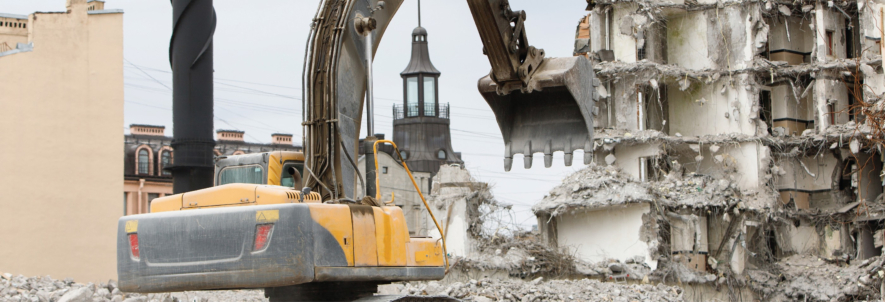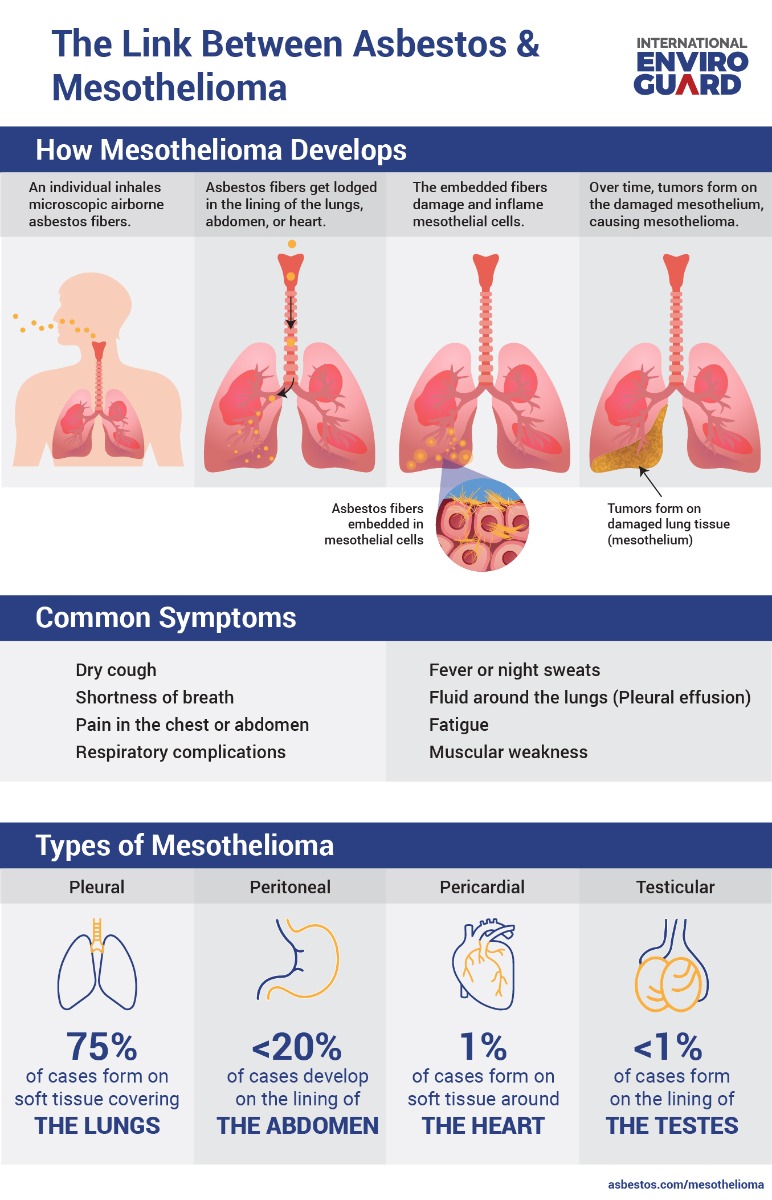
Despite the proven links between asbestos and mesothelioma cancer deaths, the deadly material continues to impact everyday people in the workplace. Although upwards of 60 countries banned the use of asbestos, major markets such as Russia, China, and the U.S. only place restrictions on how the cancer-causing agent can be used in mechanical parts and materials.
The Center for Disease Control and Prevention (CDC) indicates that despite widespread industry knowledge dating back to the 1970s, more than 45,000 Americans alone exposed to asbestos presented mesothelioma symptoms that resulted in death. What’s more, asbestos and mesothelioma cancers result in approximately 90,000 deaths worldwide each year. Compounding the threat, people who breathe in airborne particles can develop asbestosis symptoms. This leads to a debilitating and incurable chronic lung condition.
More than 125 million people worldwide remain at risk of exposure in the workplace each year. That’s why it’s essential for industry leaders to understand asbestos, the threat it presents, and to make informed decisions about disposable personal protective clothing and equipment for workers.
What is Asbestos?
It may come as something of a surprise, but asbestos is a naturally occurring element. Mining outfits pull this soft and flexible fibrous mineral from the earth. Civilizations dating back to ancient times marveled at the mineral’s properties and used it in small degrees.
It wasn’t until the 1870s that large mining operations ramped up in Europe, and asbestos was popularized for its resistance to heat and corrosion. Deemed a top insulator as well, asbestos was integrated into paper, cement, clothing, and other products. The same properties that made it a reliable manufacturing material also posed a deadly risk to workers and everyday people who inhale the small dust particles.
What You Need to Know About Types of Asbestos
The word “asbestos” tends to be a catch-all term for several minerals. When people talk about asbestos, they are referring to legal and industry-accepted terminology. According to the Asbestos Hazard Emergency Response Act, the following are considered asbestos minerals.
- Chrysotile: Ranked among the most commonly used in commercial settings, this “white asbestos” made its way into homes and businesses. Building materials, brake linings, boiler parts, and even insulation were once rife with this form of asbestos.
- Amosite: Also known as “brown asbestos,” this type was widely used in cement, pipe insulation, and products typically exposed to high heat.
- Crocidolite: Also known as “blue asbestos,” this material was routinely used for steam engine insulation as well as spray-on coatings.
- Anthophyllite: This grey, dull green, and sometimes white asbestos found limited applications in construction materials. Its use in talc creates a significant health risk.
- Tremolite & Actinolite: To date, these types have not been employed commercially.
The U.S. Environmental Protection Agency (EPA) began regulating these types of asbestos in 1986. Although workers would expect the threat of exposure to be eliminated 35 years later, that has not been the case.
Although the global production of asbestos continues to slow, countries such as Russia, China, and Kazakhstan, continue mining and exporting operations. Approximately 2 million tons of asbestos are processed annually, and the U.S. imported an additional 300 tons in 2020. That figure marked a significant increase over the 172 tons in 2019, the lowest amount in more than five years, according to a U.S. Geological Survey Mineral Commodity Summary. Although the general public has been largely educated about the material, the critical threat of asbestosis and mesothelioma symptoms increases year-over-year.
The U.S. Bureau of Mines and the National Institute for Occupational Safety and Health (NIOSH) identified a variety of asbestos-like minerals that health and safety agencies have been slow to regulate. These reportedly include erionite, richterite, taconite, and winchite, among others. NIOSH indicates that these and other minerals possess fibers that may present a similar danger.
What is Mesothelioma?
This typically develops in the layer of tissue surrounding internal organs. It tends to be extremely aggressive, and the term “Mesothelioma” generally refers to the potentially deadly form of cancer.
Medical experts and researchers recognize two distinct types of Mesothelioma. When cancer spreads in the lungs, it is called pleural mesothelioma. This ranks among the most common and deadly of the two. When the tissue surrounding the heart, abdomen, or testicles is affected, medical professionals generally deem it peritoneal mesothelioma. Although peritoneal mesothelioma may be considered less common, it can prove equally deadly.
What Causes Mesothelioma?
A scientist might explain that cancer starts at the cellular level. An agent, such as asbestos, may impact the DNA, and harmful mutations follow. Those cell changes grow at an unchecked rate and form tumors. Those tumors, in turn, spread and affect vital organs such as the lungs.
But commonsense dictates that workers and industry leaders look at the physical environment. Breathing in asbestos, having particles get caught in the eyes and ears, or inadvertently swallowing and/or inhaling dust remain the root cause of initial mesothelioma symptoms and the potentially deadly cancer that follows.
What are Common Mesothelioma Symptoms?
Considered the most common, Pleural Mesothelioma is the form that attacks the tissue around the lungs. The following are telltale Pleural Mesothelioma symptoms.
- Persistent Chest Pain
- Painful Coughing Fits
- Shortness of Breath or Lightheadedness
- Lumps Under Skin in the Chest Area
- Significant Weight Loss
Although not nearly as common, Peritoneal Mesothelioma symptoms should not be dismissed as passing illnesses. If someone has been exposed to asbestos and experiences the following Mesothelioma symptoms, it’s vital to see a doctor.
- Abdominal Pain or Swelling
- Nausea or Vomiting
- Unexplained Weight Loss
Workers who may have been exposed to asbestos would be wise to get an examination if they experience chest discomfort. Cancerous growths can sometimes go undiagnosed in people with cardiovascular disease. When the condition affects the testicles, males often experience swelling, or an unusual mass may develop.
What is Asbestosis?
Asbestosis is a debilitating lung condition often attributed to breathing in asbestos dust particles. The chronic condition involves scar tissue formation in the lungs that inhibit the free flow of oxygen and reduce the organ’s ability to function. According to the American Lung Association, scar tissue develops when the lungs fight to remove the dangerous particles, unlike the relationship between asbestos and mesothelioma.
The lungs become damaged, and the Asbestosis condition usually worsens with time. Some survive with Asbestosis in a state of diminished health and discomfort. Many eventually succumb to lung failure. Common Asbestosis symptoms include the following.
- Tightness in the Chest
- Chest Pain or Discomfort
- Unexpected Weight Loss
- Loss of Appetite
- Widening of the Fingertips & Toes
Although asbestosis causes diminished lung capacity and remains incurable, early detection can improve health and wellness outcomes. Workers who were exposed to asbestos may undergo ongoing treatment to slow the scarring process.
Workers at High-Risk of Asbestos Exposure
Industry leaders and workers would be wise to remain vigilant about the threat of asbestos exposure. Millions of tons of toxic material have been introduced to old buildings, and the fibers continue to be used despite potentially dire health effects. Upwards of 70 percent of asbestos-related conditions reportedly were linked to workplace exposure.
Asbestos materials are considered relatively odorless and tasteless. They often go airborne when materials that seal them in place are broken, or friction occurs. The dust particles can enter the lungs when breathed in or enter the body through the mouth, ears, or eyes. These rank among the occupations most commonly exposed to asbestos.
- Construction Workers: Generally cited as the highest risk occupation for asbestos and mesothelioma conditions, data indicates construction workers suffered the highest cancer rates. Construction workers are tasked with handling asbestos-laced materials, and demolition often sends deadly particles airborne.
- Engineers: Because these professionals often work at building and demolition sites, they are inadvertently exposed to asbestos particles. Because the fibers are scentless, tasteless, and not always visible, people working in a variety of construction-sector jobs suffer exposure.
- Breathable: Burning buildings send heat-resistant asbestos material into the air, especially in older buildings. Although firefighters must adhere to strict safety equipment standards when taming a blaze, the particles reach those carrying out tasks on the periphery. Asbestos fibers also may attach to outerwear and transfer to the skin when removing gear. A CDC report indicates that twice as many firefighters contract malignant (cancerous) mesothelioma.
- Manufacturing: Industrial workers continue to be exposed in old manufacturing plants. Some corporations still use asbestos materials in their products.
- Military Personnel: It shocks everyday people to think that veterans comprise a high percentage of people with mesothelioma symptoms and confirmed diagnoses. All branches of military service report increased rates. However, Navy personnel remain at an elevated risk because many ship components include asbestos, and the material is used to minimize the risk of fire.
Other high-risk industries include oil and chemical refineries, power generation, shipbuilding, and railroad workers, among others. That’s why industry leaders and workers require a complete inventory of disposable personal protective clothing and equipment available at all times.
Which PPE Can Help Protect Against Asbestos Exposure?
The necessity of wearing personal protective equipment (PPE) when in the vicinity of asbestos cannot be understated. Along with wearing an industry-rated mask or respirator, protective clothing dramatically reduces the risk of skin contact.
Depending on the industry's rigors, lightweight protective clothing options such as International Enviroguard’s Body Filter 95+® with a bouffant cap could be a strong deterrent. These disposable products prove effective in manufacturing, chemical production, and other industries. In a setting that uses asbestos for heat insulation, products such as the fire-resistant PyroGuard® are applicable.
The key point is that workers require PPE that covers their skin, hair, eyes, and ears, as well as preventing airborne asbestos fibers from entering the lungs. No amount of asbestos is safe, and that’s why organizations need a complete PPE stock for workers. International Enviroguard produces disposable protective clothing that exceeds industry standards and protects workers from asbestos exposure.
Browse our wide variety of asbestos PPE or contact us to find what you need:
